#Nigel aldcroft Jackson
Text
"The traditional metaphysics of Elfland lie at the heart of true Witchcraft, a body of ancestral faery teachings and arts which formed a hidden tradition transmitted down the centuries across Europe and the British Isles. The historical documentation provides ample evidence of the witches' trafficking with Faerie and their close associations with faery beings and the people of the Sidhe, 'the lordly ones in the hollow hills'.
The underworldly realms of the Sidhe is conceived of asbeing literally 'beneath' the earth, 'underneath' the surface phenomena of nature and middle-earth as an underlying depth-dimension of archetypes and endlessly regenerated potentialities. This is the spiritual landscape of Elfhame where the 'People of Peace' dwell, known to the Irish Celts as Tir Andomain and Tir Na n'Og, the Annwvyn of Welsh tradition and in Teutonic lore, the kingdom of Hel. In the mediaeval period the chthonic realm was known as the Land of Faerie.
In the Netherworld we descend to the very roots of being, into the faery radiance which emanates from the haunted mounds; concealed in the depths is the secret source of generation, death and rebirth for it is the place where the souls of the dead reside between incarnations according to traditional lore. There, the dead are restored and renewed by partaking of the sacred fruit, the apples of the Otherworld plucked from Mother Holle's subterranean orchard or from the trees of Ynys Afallon, ruled over by Morgan Le Faye. The Silver Branch or Craebh Sidhe, which allows passage into Elfland, is a bough upon which three silver apples hang, emitting faery music that entrances all who hear it.
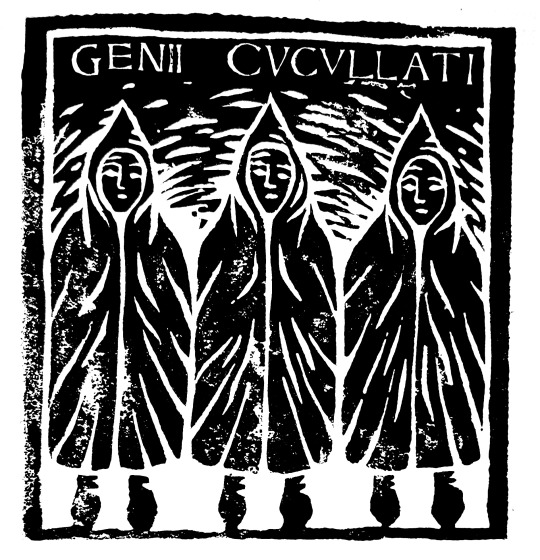
The 'Hooded Ones', the land-spirits and faery ancestors of ancient Britain; their pointed hoods became the caps of the pixies.
Our ancient forebears possessed a perpetual awareness of other worlds and states of reality which at particular times and places could break through' into our world, often in eerie and eldritch ways. There were also traditionally known loci where the worlds touched, places of intercommunication between middle-earth and Elfland such as trees, mounds, hills, caverns, watercourses, pools and wells. At these sites passage between the worlds could, and still can be effected through the use of the faery arts.
The kingdom of the Sidhe exists outside and beyond the cycles of space/time which govern the material universe - it is well known that travellers to Faerie have spent years there only to find mere minutes have elapsed upon their return to our world. Those who reside for a night in that land may find that centuries have passed when they come back into middle-earth. Elfhame lies outside the circles of time and this mysterious atemporality is the inner key to the metaphysics of rebirth and the cyclic reincarnation of ancestors in their tribal and familial descendants.
Elfland is inhabited by a diversity of intelligences ranging from the divine beings and godlings within the earth to divinized ancestral-souls and non-human faery-entitities, theriomorphs and ornithomorphs. All these beings can be accurately described as faeries, for they all inhabit that mode of existence which is utterly 'other' - the wild and mysterious faery 'state'.
According to the inner doctrine of the faery-faith, the post-mortem soul descends into Elfhame and enters into the state of the Sidhe, sojourning as a faery in the otherworld whilst awaiting the right cyclical patterns which will enable it's earthly rebirth to occur, usually in the body of a clannic descendant. The spirits of the dead thus become mystically unified with the inner heart of the land, merging with particular loci such as hills or trees for the world of the Faerie is the inherent spiritual dimension which exists concealed within the natural landscape as it's inner archetypal reality.
The human' and the 'faery are the two poles of our being between which we oscillate through our transmigrational cycles of rebirths, our countless discarnations and incarnations. In other words, the Sidhe are ourselves awaiting birth in middle-earth and we ourselves are the Sidhe awaiting our return to Elfhame. The faerie Craft is concerned with regaining the totality of our awareness, bridging our human and faery natures and activating the 'Sight of the Two Worlds' or 'Second Sight', the faculty of trance-seership and direct spiritual vision into Elfhame.
The dead thus become faeries between incarnations and certain souls in the underworld may, in time, undergo a complete faery metamorphosis and no longer incarnate as human-beings - these are the 'Master Men' of Scottish witch-lore. The identification of the faery- faith as an ancestral cultus clarifies many hitherto obscure problems and allows us an insight into the destiny of the soul and it's post mortem relationship with the noumenal and natural environments. The Faery Rade or Sluagh Sidhe rides out at Halloween, the liminal and intercalendary time of the hallowed ancestral souls. This Faery Host manifests along the dead straight 'faery passes' which link the sepulchral tumuli which are their forts, changing their hunting-grounds at the four Quarter-Days. These 'faery-roads' are a Celtic analogue to the Dutch 'death-roads' and German 'Geisterweige', the Saxon 'deada waeg', the tracks of the Wild Hunt and the spectral Black Dog and the traditional English Corpse-Roads', 'Coffin-Paths' and 'Church-ways' - they are all funereal lines of spirit-movement which link burial places, graveyards and mounds. On the west coast of Ireland much oral folk-lore makes the identity of the faeries as the souls of the departed very clear for they say that if you have many dead friends you will have many good faeries about you. The Sidhe of Irish tradition and the Elves in German folklore, are the chtonic faery-ancestors, divinized souls who have passed below the land and who exert a subtle influence upon the living in whom they await rebirth, mysteriously informing their minds and bodies from the depths of the hidden kingdoms. As Jacob Grimm astutely observed: "The dead were known to the Norsemen as elves."
—
Call of the Horned Piper
9: 'Faerie Witchcraft & the Geography of Elfland'
by Nigel Aldcroft Jackson
129 notes
·
View notes
Text
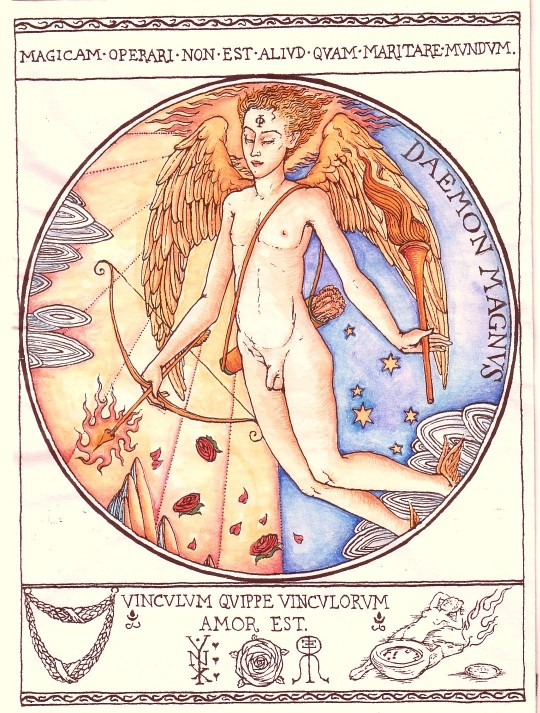

“All affections and bonds of the will are reduced to two, namely aversion and desire, or hatred and love. Yet hatred itself is reduced to love, whence it follows that the will’s only bond is Eros.”
Giordano Bruno, “Theses de Magia“ Vol. LVI (c. 1591)
An approximate translation of the Latin text across the top of the image is: “Magic does not work unless you marry the world.”.
The text on the bottom says: “The binding link is love”.
Eros is the “Daemon Magnus” (”Great Daemon”).
Below:
The Lover and the Beloved
by Nigel Aldcroft Jackson.
17 notes
·
View notes
Photo

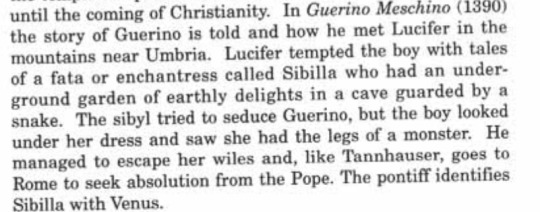

on Dame Venus, from Pillars of Tubal Cain by Michael Howard & Nigel Aldcroft Jackson
15 notes
·
View notes
Quote
The dead thus become faeries between incarnations and certain souls in the underworld may, in time, undergo a complete faery metamorphosis and no longer incarnate as human-beings - these are the 'Master Men' of Scottish witch-lore. The identification of the faery-faith as an ancestral cultus clarifies many hitherto obscure problems and allows us an insight into the destiny of the soul and it's post-mortem relationship with the noumenal and natural environments. The Faery Rade or Sluagh Sidhe rides out at Halloween, the liminal and intercalendary time of the hallowed ancestral souls. This Faery Host manifests along the dead straight 'faery passes' which link the sepulchral tumuli which are their forts, changing their hunting-grounds at the four Quarter-Days. These 'faery-roads' are a Celtic analogue to the Dutch 'death-roads' and German 'Geisterweige', the Saxon 'deada waeg', the tracks of the Wild Hunt and the spectral Black Dog and the traditional English 'Corpse-Roads', 'Coffin-Paths' and 'Church-ways' - they are all funereal lines of spirit-movement which link burial places, graveyards and mounds. On the west coast of Ireland much oral folk-lore makes the identity of the faeries as the souls of the departed very clear for they say that if you have many dead friends you will have many good faeries about you. The Sidhe of Irish tradition and the Elves in German folklore, are the chthonic faery-ancestors, divinized souls who have passed below the lands and who exert, a subtle influence upon the living in whom they await rebirth, mysteriously informing their minds and bodies from the depths of the hidden kingdoms. As Jacob Grimm astutely observed: "The dead were known to the Norsemen as elves."
Nigel Aldcroft Jackson, The Call of the Horned Piper, pgs. 51-52
#fairies#faery#fairy faith#elves#sidhe#sluagh sidhe#witchcraft#traditional witchcraft#Magic#folklore#elfhame#Elphame#quotes#call of the horned piper#nigel jackson#nigel aldcroft jackson
214 notes
·
View notes
Quote
The ‘human’ and the ‘faery’ are the two poles of our being between which we oscillate through our transmigration cycles of rebirths, our countless discarnations and incarnations. In other words, the Sidhe are ourselves awaiting birth in middle-earth and we ourselves are the Sidhe awaiting our return to Elfhame. The faerie Craft is concerned with regaining the totality of our awareness, bridging our human and faery natures and activating the ‘Sight of the Two Worlds’ or ‘Second Sight’, the faculty of trance-seership and direct spiritual vision into Elfame.
“Faerie Witchcraft & the Geography of Elfland” in Call of the Horned Piper by Nigel Aldcroft Jackson
#sidhe#fae#faerie#witchblr#wicca#green wicca#pagan wicca#witchcraft#eclectic wicca#faerie witch#nigel aldcroft jackson
27 notes
·
View notes
Text

Venus
“Venus” by Nigel Aldcroft Jackson.
The number 7 is sacred to the Goddess, and so the magic squares below are 7 x 7 grids, with 49 cells each.
The lines in the magic square on the right add up to 175. Combining these numbers (1 + 7 + 5) gives 13 (Death Major Arcana), which then reduces (1 + 3) to 4.
The fourth Major Arcana (Archetype) in the Tarot is the Empress, associated with Venus and Verdant Green Nature.
The sacred symbol of the Goddess, the Rose at the Heart of Everything, is shown in the four corners. Love is Eros, the Rose.
The Empress is associated with the fourth letter of the alphabet, Daleth, Delta, D. It means a Door.
“Enter through the Image”.
107 notes
·
View notes
Photo

Skin-Leaper’s Salve- “Periodically the Varcolac enters into a profound, death-like trance during which his soul flies for to the sphere of the moon to feed on its blood. Lunar eclipses are held to occur because of the ravenous attack of these Vampyre.” (Call of the Horned Piper, Nigel Aldcroft Jackson) #witchcraft #traditionalwitchcraft #shapeshifter #skinleaper #shapeshifting #occultherbalism #magickointment #flyingointment #witchesointmwnt #poisonpath #thepoisonpath #veneficium #thepoisonpath (at Saint Petersburg, Florida) https://www.instagram.com/p/CX2THTcLRyp/?utm_medium=tumblr
#witchcraft#traditionalwitchcraft#shapeshifter#skinleaper#shapeshifting#occultherbalism#magickointment#flyingointment#witchesointmwnt#poisonpath#thepoisonpath#veneficium
9 notes
·
View notes
Photo
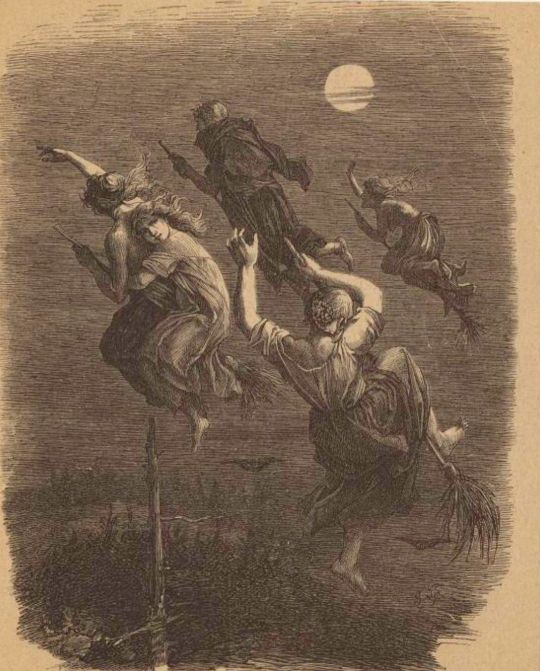
Nigel Aldcroft Jackson. “The Call of the Horned Piper.” Capall Bann Publishing. 1994. pg. 31.
25 notes
·
View notes
Quote
By the time the European witch trials began in earnest, it was generally accepted by the Inquisition and civilian witch-hunters that witches could physically fly through the air on sticks, besoms, animals, hurdles and even plants to their meetings. Obviously it is not physically possible for a human being to fly so we must look for an alternative explanation for this widely held belief. Nigel Aldcroft Jackson has explained it in terms of ‘spirit flight’, which was a state of ecstasy entered into by the witch during which he or she experiences “a flight both through states of perception and also through various Otherworlds”. In 1647 the philosopher and poet Henry More wrote:
“And ‘tis an art well known to Wizards old, And wily Hags who for fear and slave, Of the coarse halter do themselves withhold, From bodily assisting their right game, Wherefore their cases do home retain, But with their souls at these bad feasts they are, And see their friends and call them by their name, And dance about the Goat…, And kiss the Devil’s breech and taste his deadly cheer”.
Michael Howard - By Moonlight and Spirit Flight
5 notes
·
View notes
Text
RECOMMENDED READING - TRADITIONALIST
RECOMMENDED READING – TRADITIONALIST
Mastering Witchcraft – a practical guide for Witches, Warlocks and Covens by Paul Huson. Originally published in 1970 by Putnam (USA).
Seasonal Occult Rituals by William G. Gray. Originally published in 1970 by Aquarian Press.
Witchcraft a Tradition Renewed by Evan John Jones with Doreen Valiente, published in 1990 by Robert Hale.
The Call of the Horned Piper by Nigel Aldcroft Jackson and…
View On WordPress
0 notes
Text

"Hela, the Teutonic goddess of the underworld who is half dark and half fair: her name signifies the 'Veiled One'"
—
Call of the Horned Piper
'Faerie Witchcraft & the Geography of Elfland'
by Nigel Aldcroft Jackson
#call of the horned piper#nigel aldcroft jackson#traditional withcraft#faerie witchcraft#hela#Bone Mother
70 notes
·
View notes
Text
Moonlight Academy’s Witchcraft Book PDF Links
Note: I have not been able to read through all of these yet, I am slowly making my way down the list. If there is a book that is offensive or incorrect please send me a message and I will review it and remove it from the list if necessary.
Modern Magick Second Edition; Eleven Lessons in the High Magickal Arts by Donald Michael Kraig
The Witch’s Magical Handbook by Gavin Frost and Yvonne Frost
The Encyclopedia of Witches, Witchcraft, and Wicca by Rosemary Ellen Guiley
Nocturnal Witchcraft; Witchcraft After Dark By Konstantinos
Call of the Horned Piper by Nigel Aldcroft Jackson
Cunningham’s Encyclopedia of Magical Herbs by Scott Cunningham
Encyclopedia of Spells by Michael Johnstone
The Mystical World of Ancient Witchcraft; An easy Insider Guide To the life changing Power of your Magick Energy by Rose Ariadne
Old World Witchcraft; Ancient Ways for Modern Days by Raven Grimassi
The Study of Witchcraft; A Guidebook to Advanced Wicca by Deborah Lipp
Buckland’s Complete Book of Witchcraft by Raymond Buckland
The Witch’s Master Grimoire; An Encyclopedia of Charms, Spells, Formulas, and Magical Rites by Lady Sabrina
Witchcraft in Tudor and Stuart England; A regional and comparative study guide by Alan Macfarlane
The Pagan Federation; Witchcraft Information Package
Herbal Magick; A Witch’s Guide to Herbal Enchantments, Folklore, and Divination by Gerina Dunwich
The basics of Magick by K.Amber
The Book of Night Magick by Phillip D. Williams
The Encyclopedia of Celtic Mythology and Folklore By Patricia Monaghan
Celtic Mythology A-Z By Gienna Matson & Jeremy Roberts
Storytelling; An Encyclopedia of Mythology and Folklore
Norse Mythology; Legends of Gods and Heroes by Peter Andreas Munch
Constellation Legends By Norm McCarter
Encyclopedia of Greek and Roman Mythology By Luke Roman and Monica Roman
Mysteries, Legends, and Unexplained Phenomena; Mythical Creatures By Linda S. Godfrey
A Guide to Astrology By Fredrick White
How to Use Astrology; How and Why it Works By Michael Erlewine
A Manual of Astrology
Astrology for Dummies by Rae Orion
The Astrology Book; The Encyclopedia of Heavenly Influences By James R. Lewis
Astrology Course
The Cyber Spellbook; Magick in the Virtual World By Sirona Knight and Patricia Telesco
Herbs in Magick and Alchemy; Techniques from Ancient Herbal Lore By C.L. Zalewski
Cunningham's Encyclopedia of Magical Herbs By Scott Cunningham
The Magical Household; Spells & Rituals for the Home By Scott Cunningham & David Harrington
Herbs Magickal and Otherwise
The Complete Book of Incense, Oils, & Brews By Scott Cunningham
Plant Powers, Poisons, and Herb Craft By Dale Pendell **
**This book contains information on Poisons and is for informational purposes only, read at your own risk.
The Magical and Ritual Use of Herbs By Richard Alan Miller
Cunnigham’s Encyclopedia of Crystal, Gem, and Metal Magic By Scott Cunningham
The Illustrated Encyclopedia of Herbs; Their Medicinal and Culinary Uses
Spiritual Alchemy; The Inner Path
Practical Handbook of Plant Alchemy By Manfred M.Junius
Real Alchemy; A Primer of Practical Alchemy By Robert Allen Bartlett
An Illustrated History of Alchemy and Early Chemistry
Alchemy Unveiled By Johannes Helmond
Medicinal Plants in Folk Tradition; An Ethnobotany of Britain & Ireland By David E. Allen & Gabrielle Hatfield
Slavic Pagan World
Cunningham’s Encyclopedia of Wicca in the Kitchen By Scott Cunningham
Cunningham’s Book of Shadows By Scott Cunningham
Learning Tarot
The Pictorial Key to the Tarot By A.E Waite
Tarot Symbolism & Divination
Tarot; Mirror of the Soul By Gerd Ziegler
Tarot Keys By Andrea Green
The Symbolism of the Tarot by P. D. Ouspensky
Healing Crystals; The A-Z Guide to 430 gemstones By Michael Geinger
Dooney’s Crystal Database
An Introduction Guide to Crystals and Healing Stones By Ron & Sue Windred
The Healing Crystal First Aid Manuel By Michael Geinger
Practical Crystal Healing By Nicole Lanning
Divination Systems by Nicole Yalsovac
How Divination Systems Work
The Path of the witch
The Weiser Field Guide to Witches
Practicing the Witch’s Craft By Douglas Ezzy
Grimoire for the Apprentice Wizard by Oberon Zell-Ravenheart
Hope you enjoy! Please feel free to add to the list!
Moonlight Academy
#Moonlight Academy#witchcraft#witchcraft resources#witchcraft PDF files#grimoire#bos#book of shadows#witch#wicca#witchy#witchblr#wiccan#pagan#witchresources#spells#witchcraft books#witches of tumblr#eclectic witch#magick#witch journal#closet witch#closet witchcraft#witching#witchcraft masterpost#witches#secret witchcraft#discreet witchcraft#spellcraft#broke witch#broke witchcraft
17K notes
·
View notes
Text
I’m reading four books at once right now!
Gemma Gary’s “Traditional Witchcraft”
Gemma Gary’s “Black Toad”
Nigel Aldcroft Jackson’s “Call of The Horned Piper”
AND Cassandra Latham-Jones book, “Village Witch”
How do I keep up D;
19 notes
·
View notes
Quote
According to the inner doctrine of the faery-faith, the post-mortem soul descends into Elfhame and enters into the state of the Sidhe, sojourning as a faery in the otherworld whilst awaiting the right cyclical patterns which will enable it's earthly rebirth to occur, usually in the body of a clannic descendant. The spirits of the dead thus become mystically unified with the inner heart of the land, merging with particular loci such as hills or trees for the world of the Faerie is the inherent spiritual dimension which exists concealed within the natural landscape as it's inner archetypal reality.
Nigel Aldcroft Jackson, The Call of the Horned Piper, pg. 51
#witchcraft#traditional witchcraft#Magic#faery#fairy faith#fair folk#faeries#quotes#Elphame#elfhame#folklore
48 notes
·
View notes
Text
'A Short Disquisition Concerning Toad-lore'
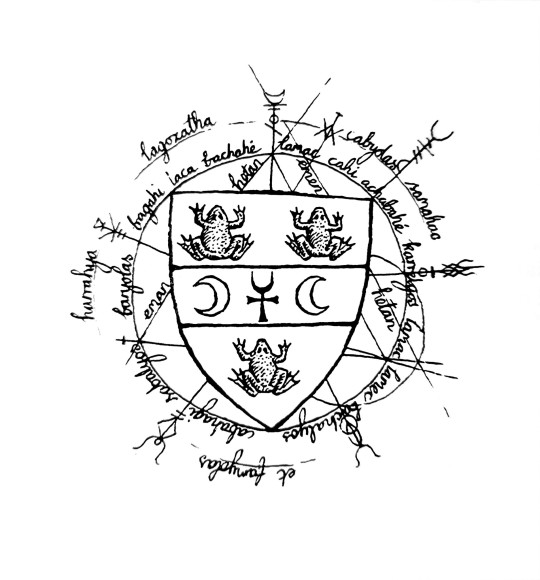
"That remarkable native amphibian, the toad or paddock (Bufo bufo), has a longstanding and celebrated association with witchcraft in the British Isles and Europe, especially as a familiar-spirit. The reasons for the importance of the toad in mediaeval witchlore must ultimately be sought in esoteric folk-symbolism, mythopoetics and the psychopharmacology of rural sorcerers and hexe-wives.
The totemic significance of the toad in witchcraft is primarily due to it's intimacy with the subterranean marshes, caves and dark waters of Annwvyn. Thus the toad is a dweller in the fens of the underworld and is especiall holy to the chthonic divinities. The toad is equally at home in the waters or on solid land, passing at will from one realm to the other just as the witch-shaman crosses the boundaries between this world and the underworld. The toad, therefore is a shamanic creature, considered symbolically, who epitomises passage between the dimensions. In this respect it should be remembered that in the Celtic world-view, marshy pools and linns were entrance points to the lower world, the great below.
At the initiations of Basque witches new devotees were marked by the Devil or Horned God with the sign of the toad or toad's foot. In mediaeval lore the heraldic crest of the Devil was held to consist of three toads emblazoned on a shield, affirming the link with the powers of the netherworld. A toad hopping over a person's foot is an ominous sign of impending death. An old Mantuan name for the toad is 'fada' or 'faery', emphasising it's otherworldly nature. In the Pyrenees it was said that witches could be recognised by an image of a frog's foot in their left eye.
The witch-trials particularly highlight the toad's function as a familiar-spirit. In the Basse-Pyrenees new witches were given toads by the Dark One. At Windsor in 1579 it was reported that "one Mother Dutton dwellyng in Cleworthe Parishe keepeth a Spirite or Feende in the likeness of a Toade, and fedeth the same Feende liyng in a border of greene Hearbes, within her Garden, with blood....." Similarly in Essex a witch in 1582 was held to own "two spirits like Toades, the one called Tom, and the other Robbyn" which she had inherited from her mother. Seventeenth Century French witches were accused of possessing 'petit Diableteaux' in the form of toads. The Italian witch Billia la Castagna in 1365 kept a large toad under her bed whose excrement was used in potions. This last detail is very significant as it is actually a cryptic reference to 'toad-stools' or visionary fungi used in witch-practices, usually of the Fly Agaric species. All across Europe there occur folk-names forcertain mushrooms which link them with toads such as Crapaudin in French.
In Slavic countries inedible mushrooms are called Zabaci Huby - "toad- mushrooms". The folk-affinities between hallucinatory fungi and toads point to an ancient awareness of the presence of psychotropic toxins in the skin of the latter. Toads secrete a fluid from their skin which contains the indole alkaloid bufotenine. Bufotenine was extracted from the glands of toads in ancient China and the traditional witches of Europe were well-acquainted with the propertiesof this batrachian elixir.
The witch-covens of north-western Spain in the 16th Century used toads' blood in their flying ointments. In 1525 Maria of Ituren confessed to having concocted a flying-salve from toad-skins and water-plantain, no doubt mingled in an oily base. Swedish witches compounded their salves with toads' fat and snake-foam along with poisonous herbs. German covens reputedly fried the toads to prepare such ointments and toad-grease salves were also utilised by witches in Hungary and Easter Europe to attain the ecstasy of 'spirit-flight'.
The toad is also famous for bearing within his head the Toadstone, a magical gem which healed all bites and stings and which, when set in a ring, grew paler in the presence of poison. In 'As you Like It' Shakespeare makes his well
known reference to the Toadstone:- "the toad, ugly and venomous, wears yet a precious jewel in his head".
This casts light on the emblem of the Black Toad in later Hermetic/alchemical literature as a glyph representing the 'earth of the philosophers' or 'first matter' which conceals within itself the wondrous Stone of the Wise.
In rural regions of England, such as Cambridgeshire, there operated a secret guild of men called the Toadmen who were reputed to exert a magical influence over horses. The Toadmen, like the secret society of the Horseman's Word, preserved many of the mysteries of the masculine side of the Craft of the Wise, honouring Old Hornie as the Master of the Beasts. To become a Toadman and gain the power a certain bone had to be obtained from a toad which was fixed to an anthill until the skeleton was entirely clean and devoid of flesh. The initiate then carried the bones in a pocket until they dried. On the stroke of midnight on the night of the full moon he cast the skeleton into a running stream: one bone would screech as it separated and floated downstream and this, when secured, conferred the supernatural powers of the Toadmen upon the bearer. Sometimes the new initiate had to take the bone to a stable or graveyard for three consecutive nights on the third night the Devil (Horned God) would appear and make a last attempt to trick the Toadman into parting with his bone as the final test of his shamanic initiation. According to some reports Charles Walton who was foully murdered in Lower Quinton, Warwickshire in 1945, was reputed by villagers to breed natterjack toads and use them in his magic - his garden was apparently thickly populated by them at the time of his death.
Toadmen were known to be practising their arts in Cambridgeshire as late as 1938 and it is not impossible that the cult may have survived clandestinely into the present day under a close shroud of rural secrecy. The toad's fertility aspects are to be clearly seen in the practices of the Auldearne coven in 1662 who performed a curious ceremony in which toads drew a plough made from the horn of a castrated ram with couch-grass for the harness. The coven went several times round a field with the toads 'praying to the Devil for the fruit of that land'. This seems to be a fragment of an ancient geomantic ritual to enhance telluric fertility. The classical author Pliny described how a toad should be placed in an earthenware pot and buried in a field to magically protect the crops from storms.
The Slavonic vampyre could appear in the guise of a frog and the paddock features heavily in [Romani] lore and tradition as a form of the Devil whose [Romani] name, Beng means “frog-like”. In Transylvanian [Romani] mythology the Queen of the Faeries lives in her remote mountain castle in the shape of a golden toad.
The recondite arcanae of toad-lore can be seen to illuminate the moste esoteric recesses of the Craft of the Wise as one of it's cardinal totemic symbols. It is thus fitting that the contemporary seeker again learns the marshland lore of the paddock as the People of the Toad did in times
past. It would seem prudent to hearken once again to his oracular croaking amidst the reeds at twilight and to pay heed to the chthonic wisdom from the haunted fens of Andumnos."
—
Call of the Horned Piper
by Nigel Aldrcroft Jackson
#call of the horned piper#nigel aldcroft jackson#witchcraft#traditional withcraft#toad lore#toad#Paddock#toadmen
124 notes
·
View notes
Text
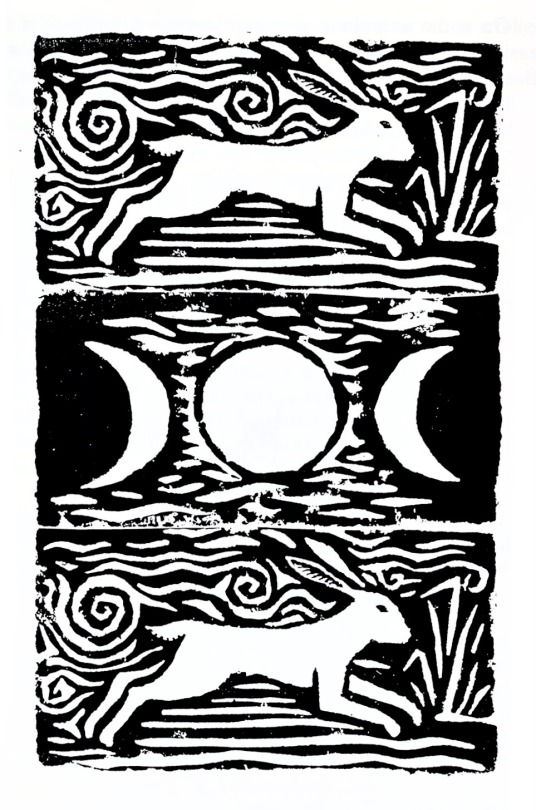
“The hare or malkin is sacred to the moon and to the Saxon goddess of dawn, spring and fecundity, Eostre.”
—
Call of the Horned Piper
by Nigel Aldcroft Jackson
95 notes
·
View notes